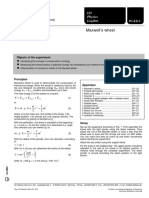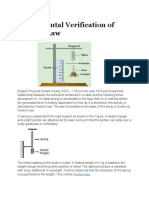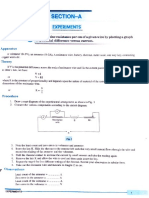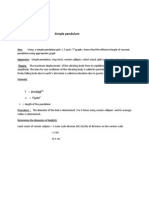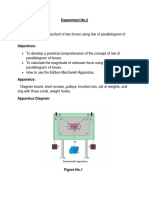Spring Constant Measurement - Static Dynamic Method
Uploaded by
PrasetyaJayaputraSpring Constant Measurement - Static Dynamic Method
Uploaded by
PrasetyaJayaputraLab Experiments
KamalJeeth Instrumentation and Service Unit
146
Vol-11, No-2, June-2011
Experiment-339 F
MEASUREMENT OF SPRING
CONSTANT BY STATIC AND DYNAMIC
METHODS
Sarmistha Sahu
Dept. of Physics, Maharani Lakshmi Ammanni College for Women, Bengaluru- 560012. INDIA.
E-mail: sarmistha.sahu@gmail.com
Abstract
Using a 2 inch diameter silky spring, its effective mass and the spring constant are
determined, both in the static and dynamic modes.
Introduction
A spring is an elastic object which stores mechanical energy. Springs are usually made of
hardened steel. Small springs can be wound from pre-hardened steel, while larger ones are
made from annealed steel and hardened after fabrication. Some non-ferrous metals, such as
phosphor bronze and titanium, are also used in making spring [1].
The spring constant, k, of an ideal spring is defined as the force per unit length and is
different from one spring to another. Spring constant is represented in Newton/meter (N/m).
It can be determined both in static (motionless) as well as dynamic (in motion) conditions.
Two different techniques are used for determination of the spring constant. In the static
method, Newtons second Law is used for the equilibrium case, and laws of periodic motion
are applied for determining the spring constant in the dynamic case.
Static mode
In this mode of determination of spring constant, a weight is added to the spring and its
extension is measured. The spring is fixed at one end and a weight is added in equal amounts
one by one. The extension produced in the length of the spring is noted from the meter scale
fixed. After adding a weight the spring will attain a stationary position after some time. At
equilibrium, there are two equal and opposite forces, acting upward and downward. In the
static mode the spring constant obtained by this method is denoted by k
s
; the subscript s
indicates that the static method has been employed for determination of the spring constant.
In the equilibrium condition,
Upward force, F
up
= Downward force, F
down
F
up
= k
s
e
Lab Experiments
KamalJeeth Instrumentation and Service Unit
147
Vol-11, No-2, June-2011
F
down
= mg
Equating the RHS of the above two equations
k
s
e = mg, or
k
s
=
1
where
m is the mass of the load applied ;
g is the acceleration due to gravity;
k
s
is the spring constant in the static condition ; and
e is the extension of the massless spring.
However, the spring has a finite mass, denoted by M
s
, which adds to the load, hence m in
Equation-1 is replaced by (m+M
s
), giving
k
s
=
(
...2
Equation-2 represents a straight line in which spring constant k
s
and acceleration due to
gravity g are constants. A graph of e versus (m+M
S
) is a straight with slope g/k
s
and Y-
axis intercept of (gM
S
/k
s
). Hence k
s
can be determined from the values of extension of the
spring with variation in the applied load.
Slope = g/k
...3
Y-intercept =
= M
s
x (slope of the line) 4
Figure-1: Silky spring used in this experiment
Dynamic mode
If the spring is made to oscillate by pulling the weight applied to it downward, it executes a
simple harmonic motion; the equation representing its motion is written as
...6
The angular velocity is given by:
Lab Experiments
KamalJeeth Instrumentation and Service Unit
148
Vol-11, No-2, June-2011
=
...7
Therefore, the time period of the oscillation of the spring is:
T = 2
...8
If the dynamic spring has an effective mass M
d
, then its time period is :
T = 2
...9
A graph of T
2
on the y-axis and the mass (m+M
d
) on the x-axis will result in a straight line
with:
Slope =
...10
Y-intercept =
= M
d
x (slope of the line) 11
where m: mass of the weight hanging
M
d:
effective dynamic mass
of the spring
e: extension of the spring
T: time period of oscillation
k
d:
spring constant
g: acceleration due to gravity
Apparatus used
Spring mass apparatus consisting of a very thin spring of about 5 cm (2 inch) diameter, fitted
on a stand, and a digital stop clock.
Figure-2: Spring mass apparatus
Lab Experiments
KamalJeeth Instrumentation and Service Unit
149
Vol-11, No-2, June-2011
Figure-1 shows the silky spring used in experiment. It always remains in the compressed
position because of its light weight. Each coil of the springs rests on the other hence it is fully
compressed. Figure-2 shows the spring mass apparatus used in this experiment. One can tie a
few spring coils together which act like a weight hanger. By increasing the number of turns,
the mass (m) hanging can be varied.
Experimental procedure
Figure-3: Measurement of spring length
1. The spring length is measured using a scale as shown in Figure-3, and its mass is
determined using a digital balance.
Spring length (X) =5.36cm = 0.0536m
Spring mass (M) = 46.72g = 46.72x10
-3
Kg
Mass per unit length = (M\X)=46.72x10
-3
/0.0536= 0.871Kg/m
Total number of turns in the spring =72
Hence weight per turn of the spring (m
0
) = 46.72x10
-3
/72=0.00065Kg/turn
2. About one third of the coil is separated, held together and fixed on to a stand as shown in
the Figure-4. The rest of the spring coils hang downward because of their own weight as
shown in Figure-4.
3. The length of the spring coils hanging in air is measured using a scale and extension of
the spring is calculated as
x = 14.4cm
The spring is now compressed by pushing it back and its compressed length or the
relaxed length x
o
is found as
x
0
= 3.3cm
The extension e = x-x
o
= 14.4-3.3=3.1cm = 3.1x10
-2
m
4. Now five turns (n=5) of the hanging coil are tied to form the mass as shown in Figure-2.
This tied mass forms the weight. The weight is pulled down slightly and released which
makes it to oscillate. The time period for 50 oscillations is counted using a digital stop
clock and the period of the simple harmonic oscillation is determined. The readings are
tabulated in Table-1.
Lab Experiments
KamalJeeth Instrumentation and Service Unit
150
Vol-11, No-2, June-2011
Time for 50 oscillations = 30.7 s
Hence period, T = 30.7/50 = 0.614 s.
Figure-4: Static position of the spiral spring
5. To repeat the trial, five more turns of the coil tied at the top are released and mass is
increased by tying 10 turns together, keeping the total number of coil turns hanging in air
the same.
6. Extension of the spring is calculated again and its period of oscillation is determined and
recorded in Table-1.
7. A graph is drawn taking mass of the spring along X-axis and its extension on the Y-axis
as shown in Figure-5. From the graph the slope and Y-intercepts are noted as
Slope =
=
(.)
(.)
= 8.203
k
s
=
.
.
= 1.194 N/m
The Y-intercept =
The effective mass of the spring in the static condition
M
s
=
=
.
.
=0.0136kg = 13.6g
8. A second graph showing the variation T
2
with mass is also drawn as shown in Figure-
6 from which the slope and intercept are calculated as
Slope =
.
(.)
=
.
.
= 34.18 =
Therefore, dynamic spring constant k
d
=4x3.14
2
/34.18=1.15N/m
Y-intercept = 0.38 =M
d
slope
Lab Experiments
KamalJeeth Instrumentation and Service Unit
151
Vol-11, No-2, June-2011
M
d
=
.
.
=0.0111Kg =11.1g
Table-1
No of
turns
tied
(n)
Mass
nm
0
X10
-3
(Kg)
Free
hanging
length
x (10
-2)
(m)
Relaxed
length of
the
spring
(x
0
)x10
-2
Extension
e 10
-2
(cm)
Time for 50
oscillations
(sec)
Period
T (sec)
T
2
0 0 14.4 3.0 11.42 30.7 30.9 0.61 0.38
5 3.25 17.3 3.3 14.05 34.1 34.1 0.68 0.47
10 6.50 20.2 3.5 16.67 38.2 37.9 0.76 0.58
15 9.75 23.1 3.7 19.30 41.6 41.8 0.83 0.69
20 13.0 26.4 4.0 22.33 44.7 44.8 0.90 0.80
25 16.25 30.6 4.2 26.36 48.6 48.1 0.97 0.93
30 19.5 32.0 4.6 27.38 50.8 50.5 1.01 1.03
Variation of period of oscillation and extension of the spring with mass
Figure-5: Variation of mass with extension of the spring in the static mode
Figure-6: Variation of mass with square of the period in the dynamic mode
0
5
10
15
20
25
30
0 2 4 6 8 10 12 14 16 18 20 22
E
x
t
e
n
s
i
o
n
(
c
m
)
x
1
0
-
2
Mass (X10
-3
Kg)
0
0.2
0.4
0.6
0.8
1
1.2
0 5 10 15 20 25
T
2
Mass (X10
-3
Kg)
Lab Experiments
KamalJeeth Instrumentation and Service Unit
152
Vol-11, No-2, June-2011
Results
The results obtained are tabulated in Table-2.
Table-2
Parameters Experimental
Spring constant in static mode (N/m) 1.19
Spring constant dynamic mode (N/m) 1.15
Average spring constant (N/m) 1.17
Effective mass of spring in static mode (g) 13.6
Effective mass of spring in dynamic mode (g) 11.1
Average effective mass (g) 12.3
Experimental results
Discussion
A new experiment is presented here using which basic properties of a spring are determined.
As no slotted weight is used, the weight of the spring itself acts like a hanging weight. The
spring used is very thin, or silky, hence all the turns (layers) of it is in contact with each other,
which makes it a compressed spring. The spring constant and effective mass obtained by the
static and the dynamic methods are nearly the same indicating that both the methods give
reasonably correct result.
References
[1] http://en.wikipedia.org/wiki/Spring_%28device%29
You might also like
- P1461 - Conservation of Energy-Maxwell's Wheel 1No ratings yetP1461 - Conservation of Energy-Maxwell's Wheel 14 pages
- American International University-Bangladesh (Aiub) : Meld's ExperimentNo ratings yetAmerican International University-Bangladesh (Aiub) : Meld's Experiment9 pages
- How To Find Acceleration Due To Gravity Using Compound Pendulum100% (1)How To Find Acceleration Due To Gravity Using Compound Pendulum7 pages
- Searles Experiment To Determine The Young Modulus0% (2)Searles Experiment To Determine The Young Modulus3 pages
- Anjali Jindal - Exp No.1 - Melde's ExperimentNo ratings yetAnjali Jindal - Exp No.1 - Melde's Experiment9 pages
- ASTM Standards Source (Textiles Collection)No ratings yetASTM Standards Source (Textiles Collection)7 pages
- American International University-Bangladesh (Aiub)100% (2)American International University-Bangladesh (Aiub)9 pages
- Lab Reports Mechanics, Heat & VibrationsNo ratings yetLab Reports Mechanics, Heat & Vibrations79 pages
- To Determine Emf of Dry Cell Using PotentiometerNo ratings yetTo Determine Emf of Dry Cell Using Potentiometer3 pages
- Experiment 2 Measurement of Voltage and Frequency Using A CRO.100% (3)Experiment 2 Measurement of Voltage and Frequency Using A CRO.12 pages
- National University of Sciences and Technology (NUST) : Lab Report100% (1)National University of Sciences and Technology (NUST) : Lab Report7 pages
- Find The Wavelength of Hydrogen Spectral Lines (Balmer Series)100% (3)Find The Wavelength of Hydrogen Spectral Lines (Balmer Series)18 pages
- Experiment: Apparatus:: To Find The Modulus of Rigidity of Copper Wire Using Maxwell's Needle50% (2)Experiment: Apparatus:: To Find The Modulus of Rigidity of Copper Wire Using Maxwell's Needle2 pages
- Experiment: To Determine The Value of G' by Kater's Pendulum. Apparatus Used: Theory: Procedure80% (5)Experiment: To Determine The Value of G' by Kater's Pendulum. Apparatus Used: Theory: Procedure2 pages
- Is Rubber More Elastic Than Steel? The Answer Lies in The Concept of ElasticityNo ratings yetIs Rubber More Elastic Than Steel? The Answer Lies in The Concept of Elasticity7 pages
- Latihan Soal Bahasa Inggris Ujian Akhir SMA Non-TeknikNo ratings yetLatihan Soal Bahasa Inggris Ujian Akhir SMA Non-Teknik4 pages
- Classical Guitar - History - I.four Course GuitarNo ratings yetClassical Guitar - History - I.four Course Guitar3 pages
- Nicolo Paganini - Grand Sonata Movement II. RomanzeNo ratings yetNicolo Paganini - Grand Sonata Movement II. Romanze2 pages
- Current Trends and Future Developments on (Bio-) Membranes: Recent Advances on Membrane Reactors 1st edition - eBook PDF All Chapters Instant Download100% (5)Current Trends and Future Developments on (Bio-) Membranes: Recent Advances on Membrane Reactors 1st edition - eBook PDF All Chapters Instant Download59 pages
- Hydraulic System:: R. Qasim Abbas D Automatic Control I 4No ratings yetHydraulic System:: R. Qasim Abbas D Automatic Control I 45 pages
- Technical Service Bulletin 17B0001N01 PDFNo ratings yetTechnical Service Bulletin 17B0001N01 PDF2 pages
- Chapter 1 Origin and Structure of The EarthNo ratings yetChapter 1 Origin and Structure of The Earth15 pages
- Balancing & Rigging - Flight Control System100% (1)Balancing & Rigging - Flight Control System44 pages
- Maths - Pre-Model - Chavakkad 2023 - EngNo ratings yetMaths - Pre-Model - Chavakkad 2023 - Eng3 pages
- Evaluating Fatigue Resistance of The Fiber-Reinforced 100% RAP Content Asphalt Mixture Rejuvenated With Waste Vegetable Oil - Farshad HaddadiNo ratings yetEvaluating Fatigue Resistance of The Fiber-Reinforced 100% RAP Content Asphalt Mixture Rejuvenated With Waste Vegetable Oil - Farshad Haddadi87 pages
- Air Flow Ball Levitation and Light Controller: Politecnico Di MilanoNo ratings yetAir Flow Ball Levitation and Light Controller: Politecnico Di Milano16 pages
- Magnetic Effect of Electric Current Pyqs Nsejs0% (1)Magnetic Effect of Electric Current Pyqs Nsejs4 pages
- Guidance On The Design and Layout of Medical X-Ray FacilitiesNo ratings yetGuidance On The Design and Layout of Medical X-Ray Facilities19 pages
- American International University-Bangladesh (Aiub) : Meld's ExperimentAmerican International University-Bangladesh (Aiub) : Meld's Experiment
- How To Find Acceleration Due To Gravity Using Compound PendulumHow To Find Acceleration Due To Gravity Using Compound Pendulum
- American International University-Bangladesh (Aiub)American International University-Bangladesh (Aiub)
- Experiment 2 Measurement of Voltage and Frequency Using A CRO.Experiment 2 Measurement of Voltage and Frequency Using A CRO.
- National University of Sciences and Technology (NUST) : Lab ReportNational University of Sciences and Technology (NUST) : Lab Report
- Find The Wavelength of Hydrogen Spectral Lines (Balmer Series)Find The Wavelength of Hydrogen Spectral Lines (Balmer Series)
- Experiment: Apparatus:: To Find The Modulus of Rigidity of Copper Wire Using Maxwell's NeedleExperiment: Apparatus:: To Find The Modulus of Rigidity of Copper Wire Using Maxwell's Needle
- Experiment: To Determine The Value of G' by Kater's Pendulum. Apparatus Used: Theory: ProcedureExperiment: To Determine The Value of G' by Kater's Pendulum. Apparatus Used: Theory: Procedure
- Is Rubber More Elastic Than Steel? The Answer Lies in The Concept of ElasticityIs Rubber More Elastic Than Steel? The Answer Lies in The Concept of Elasticity
- Latihan Soal Bahasa Inggris Ujian Akhir SMA Non-TeknikLatihan Soal Bahasa Inggris Ujian Akhir SMA Non-Teknik
- Nicolo Paganini - Grand Sonata Movement II. RomanzeNicolo Paganini - Grand Sonata Movement II. Romanze
- Current Trends and Future Developments on (Bio-) Membranes: Recent Advances on Membrane Reactors 1st edition - eBook PDF All Chapters Instant DownloadCurrent Trends and Future Developments on (Bio-) Membranes: Recent Advances on Membrane Reactors 1st edition - eBook PDF All Chapters Instant Download
- Hydraulic System:: R. Qasim Abbas D Automatic Control I 4Hydraulic System:: R. Qasim Abbas D Automatic Control I 4
- Evaluating Fatigue Resistance of The Fiber-Reinforced 100% RAP Content Asphalt Mixture Rejuvenated With Waste Vegetable Oil - Farshad HaddadiEvaluating Fatigue Resistance of The Fiber-Reinforced 100% RAP Content Asphalt Mixture Rejuvenated With Waste Vegetable Oil - Farshad Haddadi
- Air Flow Ball Levitation and Light Controller: Politecnico Di MilanoAir Flow Ball Levitation and Light Controller: Politecnico Di Milano
- Guidance On The Design and Layout of Medical X-Ray FacilitiesGuidance On The Design and Layout of Medical X-Ray Facilities




